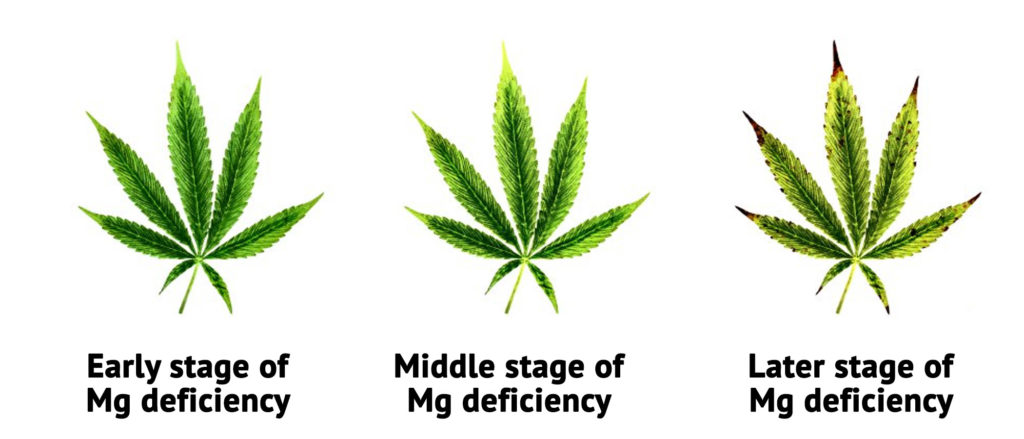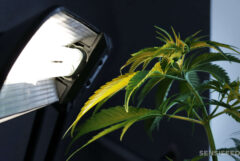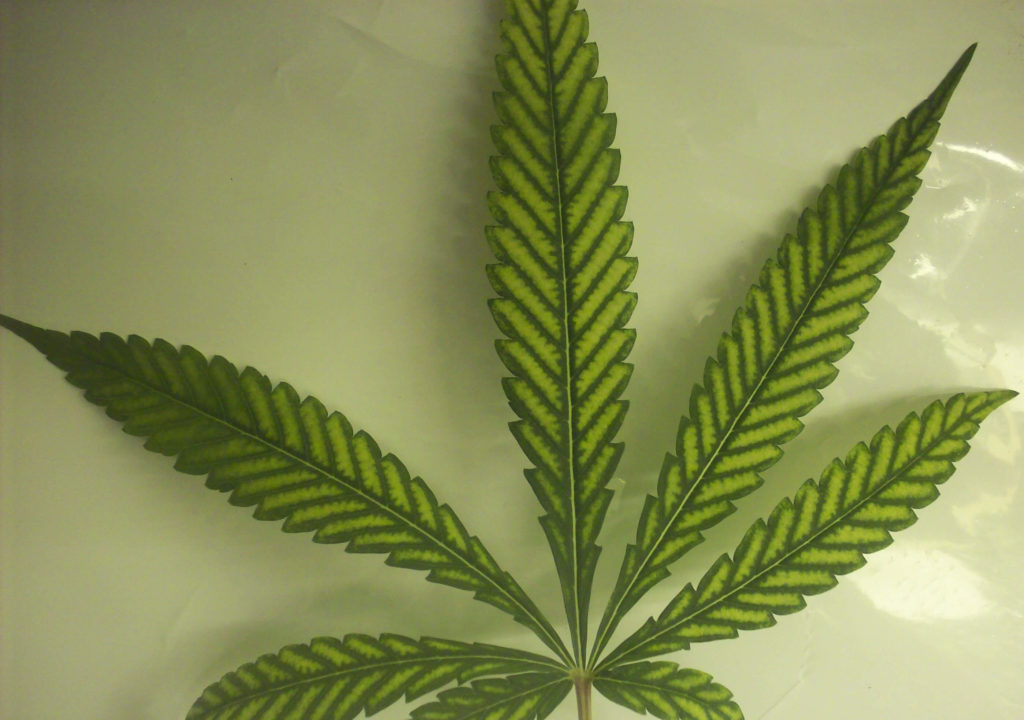After the three main nutrients (nitrogen, potassium and phosphorous), magnesium is the most crucial secondary nutrient for healthy growth and development of cannabis plants. Without it, plants wither, fail to thrive, and eventually die. What does a cannabis plant with magnesium deficiency look like, and what can be done to help it recover? Help is at hand!
- Why do cannabis plants need magnesium?
- How can magnesium deficiency in cannabis plants be identified?
- What are the dangers of magnesium deficiency in cannabis?
- What causes magnesium deficiency in cannabis plants?
- How can magnesium deficiency in cannabis be corrected?
- Quick fix for magnesium deficiency in cannabis
Why do cannabis plants need magnesium?
The reason that plants – and not just cannabis plants – need magnesium is simple: it is essential for photosynthesis. Without it, leaves cannot absorb and process light into energy. Plants with magnesium deficiency will eventually starve to death, even if they are getting the correct amount of hours of light.
How can magnesium deficiency in cannabis plants be identified?
As the primary ‘building block’ of chlorophyll, magnesium is what gives it, and therefore the plant itself, a healthy bright green colour. The first and most easy to identify sign of magnesium deficiency in cannabis plants is the leaves showing a worrying fade of green to pale green to yellow.
This is known as chlorosis. Although there are other problems that also cause chlorosis, magnesium deficiency in cannabis shows up first around the edges and in between the veins on the leaves, rather than all over them or from the stems outwards or tips inwards.
The first leaves to show these signs will be the oldest ones, and the ones closest to the bottom of the plant (often, these are the same ones). This is caused by the plant withdrawing magnesium from these leaves in order to send it to the newer ones, in an effort to keep itself alive (in much the same way as the human body pulls blood away from the extremities in cold weather to keep the vital organs warm).
The leaves might also start to feel crunchy and dry, although it is not advisable to wait until this happens before starting treatment!
What are the dangers of magnesium deficiency in cannabis?
Not only is magnesium essential for photosynthesis, it is needed for the absorption of other vital nutrients. These especially include nitrogen and phosphorus, two of the three primary nutrients. As well as being unable to photosynthesise, plants will be unable to develop sufficiently large and healthy root systems and flowers. This is obviously bad news for the plants themselves, and for anyone hoping to harvest those flowers!
Indeed, cannabis plants with magnesium deficiency may not even make it to the flowering stage. As its supply of magnesium is depleted, more and more of the leaves will turn yellow, then brown, and eventually drop off, causing the plant to die.
What causes magnesium deficiency in cannabis plants?
Unsurprisingly, the first culprit is not enough magnesium in the soil. It is an unfortunate fact that magnesium can be quite easily washed away by flushing or overwatering. The good news is that depending on where you live, your tap water may actually contain useful levels of magnesium!
Even if there are sufficient levels of magnesium in the soil, the plant may not be able to make use of them. A substrate with a pH value that is too low, i.e. very acidic, prevents the roots from absorbing magnesium even if it is plentiful. It is also important to know that adding more magnesium to a substrate that already has enough can make the situation worse.
Other necessary nutrients can be ‘locked out’ by an excess of magnesium in the substrate, and suddenly the gardener has multiple nutrient deficiencies to deal with, not just one!
How can magnesium deficiency in cannabis be corrected?
Testing levels of magnesium in a substrate is difficult without laboratory analysis, something that very few people have easy access to. The best solution would be to correct everything that could be causing problems rather than attempting to tweak one thing at a time.
The most common way to correct pH and remove excess nutrient build-up in a non-soil substrate such as coco coir, or in a hydroponic system, is a thorough flush with pH-balanced water followed by another flush with pH-balanced water supplemented with regular cannabis nutrients. In hydro systems, the pH should be 6.0 – 6.5 for the best magnesium uptake.
The exact type of nutrient ratio will depend on whether the plants are in the vegetation or flowering phase. Obviously, it’s important to make sure that the nutrient solution used contains magnesium. It is also recommended to check that it contains calcium, as calcium deficiency often occurs in tandem with magnesium deficiency.
Growing cannabis plants in soil, especially in open ground rather than pots, makes them far less likely to suffer from magnesium deficiency. However, it does not guarantee immunity! In soil, the pH should be 6.0 – 7.0. The same flushing technique can be applied as above, and then a specialised magnesium and calcium supplement (available at good garden centres) can be added.
Quick fix for magnesium deficiency in cannabis
As a quick-fix emergency measure, mixing magnesium sulphate with water to make a foliar spray is often effective. Magnesium sulphate is sold under the name Epsom salts, and is easy to get online or from large pharmacies.
A magnesium foliar spray is made by mixing one tablespoon of Epsom salts with four litres of water. This mixture is then sprayed onto the plants every three days, with a clean water spray every ten days to ensure residue does not build up on the leaves.
We hope that this article has been informative about magnesium deficiency in cannabis plants! Do you have any tips for us? Please leave them in the comments below. Do you have questions about magnesium, or other types, of deficiencies? Please consult our forum, where a thriving community can help you find the answers.
- Disclaimer:While every effort has been made to ensure the accuracy of this article, it is not intended to provide legal advice, as individual situations will differ and should be discussed with an expert and/or lawyer.













What do I use to make my own cal/mag mixture? Epsom salt and egg shells?
Yes, take 6-12 egg shells, toast in the oven at 250 for about 15min. You want some shells burnt and some still kinda white. Then crush as good as possible(I used a coffee grinder),and put powder in a jar and let soak with a ratio of 1:10 in vinegar(brown rice vinegar the best)for 7-20 days.
How do I get rid of spidermites of which is multiply day by day ,actually I am using biological Spraying, pesticides.
It happened to me to over water the plants.
Then I used cal mag 6 ml per gallon and watered the soil bag right away it get better green leaves.
I thought mine was fungus grants. I have been using Cal Mag. Does fungus grants Cause the same situation
Hi Mel,
Unfortunately, legal restrictions mean we can’t answer grow-related questions or give grow advice on this blog. However, other readers of this blog will often answer questions like yours. Sorry I can’t be of more help, and I hope you continue to enjoy the blog!
With best wishes,
Scarlet
Hey Mel,
Did you ever figure out if it was fungus gnats or Mag?
When When doing Epsom salt spray to leaves should the light be on or off
Fungus gnat infestations will show as all sorts of nutrient deficiencies as the larvae damage the roots and in turn disrupt the plants ability to uptake nutrients correctly, get rid of the gnats. Throwing nutrients at it will just cause other nutrients to get locked out.
Hey Shawn, sooo Your saying I shouldn’t use epsom salt if I have fungus gnats? Any recommendations on how to get rid of fungus gnats?
easy way to get rid of fungus gnats – cover the top of your soil in 1 to 2 inches of sharp sand, I think in the USA its known as river sand or grit sand. The sand will prevent the gnats getting into the soil and any larvae will remain trapped and die.
I am a new grower and have found this article to be the saving grace of my grow! Thank you for the pics that easily identified the issue I’ve been facing.
very useful
Great article. The pictures really help people because a lot different deficiencies have the same symptoms. But these in this article were spot on with what I’ve seen in my plants myself and exactly how they looked at the time. The PH must be correct to diagnose the nutrition symptoms and deficiencies.
My leaves continue to yellow going up middle of plant i flushed completely and foilage sprayed with epson salt how must i water next.and what must i put in water help